Betta fish are beautiful, unique fish to keep in your aquarium. They come in a variety of colors, patterns, and tail shapes, which makes them so unique.
Most have a color and pattern combination. Solid-colored Betta fish are rarer. You could just spend hours looking at Betta fish!
However, Bettas are known to be aggressive and territorial. To prevent this from happening, there are some things you can do, and you can find this out in our Betta fish guide. Also, there are other things you should know, such as what do you need for a Betta fish.
Here, you can find exactly how to care for a Betta fish. This ultimate guide can help you ensure your beautiful Betta fish are well cared for and live a happy, long life.
So let’s dive right in!
Contents
What Is A Betta Fish?

A Betta fish, aka Siamese fighting fish or labyrinth fish, is a beautiful type of fish that originates from Asia. They’re colorful and have beautiful surreal fins. However, they are one of the most aggressive fish out there.
Find out more about this unique fish below, where we talk about its appearance and behavior.
Betta Fish Appearance
Betta fish have beautiful vibrant colors and unique tails. Not all fish from this species look similar, as their color, pattern, and tail shape are often different for each fish. Here are all of the possible variations:
Color
Betta fish can literally be any color or pattern you can think of. They can also be a combination of multiple colors and patterns. The most common colors include red, black, yellow, and blue. They can also be clear, albino, and, more rarely, purple. An interesting fact is that female Bettas are less colorful than male ones.
Pattern
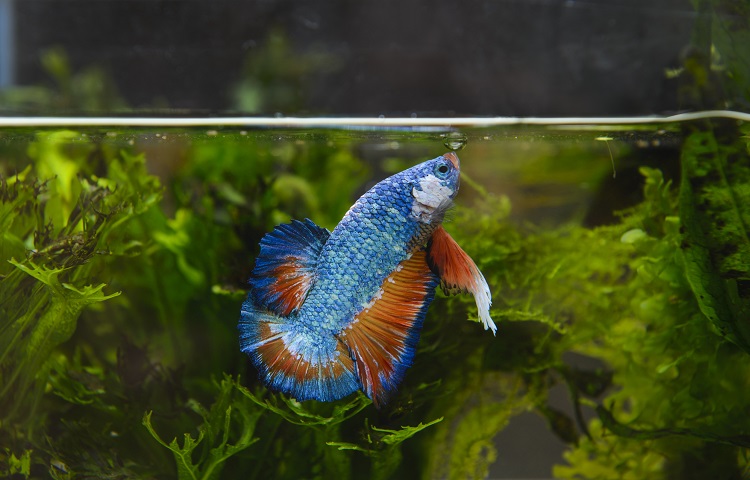
It’s rare that Betta fish only have one color, but they do exist. Usually, there are four main patterns for these fish.
The most common one is bi-color. Bi-colored Bettas are probably the most common type of Betta fish. As the name indicates, they can be any combination of two colors and a variety of patterns. The fish’s body is one color, and the fins are another.
Butterfly Bettas are similar to bi-colored ones. They also have one color for their body and another one for their fins. The only difference is that the body color butterfly Betta fish often merges into their fins.
The third common pattern for Betta fish is grizzled. As you can probably tell by the name, these fish have a grizzled look, with an overall iridescent effect on their body and fins. It often looks like these fish are painted, as they look so surreal. These particular Betta fish usually have a 50-50 light to dark colors ratio.
Another common example is the marbled pattern. Just like grizzled Betta fish, marbled fishes have light colors on half of their body and dark colors on the other half of their body. The contrast of light and dark colors is usually very noticeable.
There are many more Betta types not mentioned above, but it would be too long to list them all! However, if you’re interested in less common Betta fish, I suggest you take a look at these: alien Betta, dragon scale Betta, paradise Betta, plakat Betta.
Tail shape
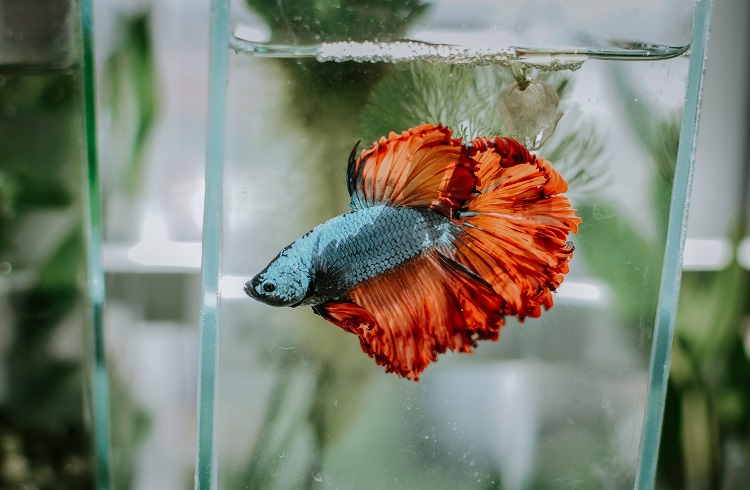
Now that you know that Betta fish can come in every color and pattern, so it’s no surprise that there are also several tail shapes. The most common ones include veiltail, delta, double tail, combtail, crowntail, and halfmoon.
Veiltail Bettas are probably the most common type of Betta fish and the one people usually picture when they think of Bettas. Veiltails have long, sleek fins that swoop downwards. As for delta Bettas, they’re less common and more unusual. Their fins narrow at the top of their body and then fan out at the tail fins.
Double tail Bettas have two separate tail fins, just as you can guess from their name. This gives them a unique and interesting shape.
Since we’re talking about interesting shapes, combtail Betta fish have fins that look like a comb, as suggested by the name. The fin webbing usually reaches two-thirds of its way down to the fins. They look similar to the Veiltail ones but have a more rugged look.
Crowntail Betta fish look similar to combtail Bettas, with a more fringed edge. Finally, we have halfmoon Betta fish, which, as you can tell by the name, have a famous half-moon shape, so basically a half-circle. These are probably the most beautiful Betta fish out there and look even more majestic than veiltail Bettas.
As you can see, Betta fish can come in a variety of colors, patterns, and tail shapes! So you have plenty of options, and you can be sure that your fish tank will look even more beautiful.
Betta Fish Behavior
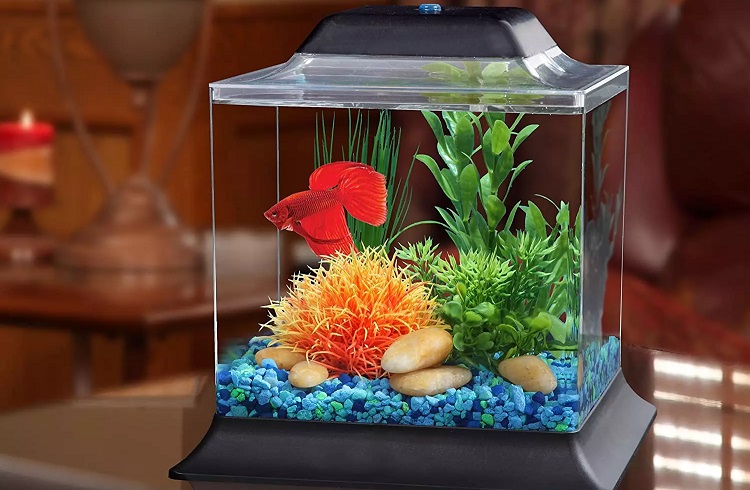
Now that you’re more aware of the most common color, pattern, and tail shape variations of Betta fish, let’s talk about the behavior of this fish breed.
As you might know, Bettas are known to be aggressive and territorial, so some people shy away from getting them. If you put them with the wrong tank mate, things can indeed degenerate very quickly.
Keep in mind that each male or female Betta fish can have a different personality and behavior. So here’s everything you need to know about their behavior and how to avoid conflict with other fish.
Male Bettas behavior
Male and female Betta fish have different behaviors. So let’s start with male Bettas, which are usually more aggressive and territorial than female Bettas.
Male Betta fish are solitary, so they tend to do very well by themselves. In fact, we advise you to keep them alone in a separate fish tank. This way, there’s no risk in your Betta harming your other fish, and your male Betta will be fine and happy on its own.
Otherwise, if you keep two male Bettas together, even in a very large fish tank, they’re very likely to fight until death. Betta fish can also confuse bright-colored fish with long fins for other male Bettas, so avoid putting these in the same tank.
You should also avoid putting any mirror in the fish tank or holding one against it. Your Betta fish might think it’s another male Betta and get really aggressive. Along the same vein, avoid showing your fish a picture of Betta fish.
Another strange behavior male fish have is to build a bubble nest for any potential offspring, even if there are no female Bettas in the fish tank.
Female Bettas behavior
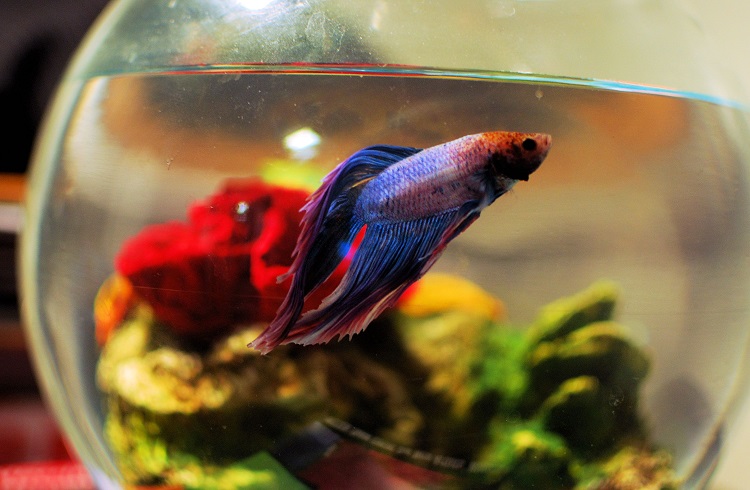
Even if female Bettas tend to be less aggressive than male Bettas, you should still be careful. They can sometimes be territorial and even fight each other.
You can keep females in sororities, in groups of five or more, with Bettas of a similar age. The important thing to keep in mind with a sorority is that you need a fish tank with a lot of space, so there’s no risk for aggressive or territorial behavior. Also, not every female Betta is suitable for sorority life.
Tank mates
As you can see above, things can get bad really quickly with Betta fish if you pair them up with the wrong tank mates. To avoid displays of aggression and territorial behavior, choose the right tank mates and give your Betta fish plenty of space in the fish tank.
Here are some recommended tank mates for Betta fish to keep a peaceful tank environment: Corydoras Catfish, Tetras, snails, Ghost shrimps, Glass Catfish, Mollies, Celestial pearl danios, White Cloud Mountain Danios, and Yoyo loaches.
There are many more suitable tank mates, but these are the most common and recommended ones. As long as you find peaceful and bottom-dwelling fish for your Betta fish, it should be fine. Or you can put your Betta fish in a tank alone. It won’t get lonely.
Avoid “fin nippers,” which could bite your Betta’s fins and aggressive fish in general. Otherwise, your Betta fish can be aggressive, stressed, or even experience fin rot.
How Does A Healthy Betta Fish Look?
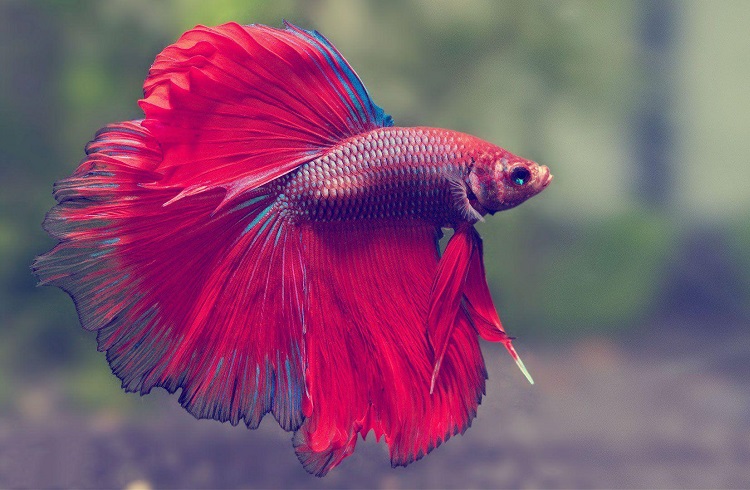
There are some signs that can tell you if your Betta fish looks healthy.
The most common signs are aggressive reactions, energetic and fast movements, a healthy appetite, vibrant colors (especially for males), healthy and flowy fins, and interaction at the surface.
How Does A Sick Betta Fish Look?
Just like there are signs that your Betta fish is healthy, there are also some that can tell you if your Betta could be sick.
These include a lack of energy, appetite loss, irregular and abnormal swimming, damage or irregularities on its body, dull colors (particularly for males), and curved or even wuthering fins and tail.
Common Diseases that Affect Betta Fish
Just like our world has its share of illnesses, the underwater realm is no stranger to diseases. Hence, understanding the common ailments that can befall your Betta fish will better equip you to take immediate corrective action.
1. Fin Rot
Symptoms: Keep an eye out for frayed or deteriorating fins, a sign of trouble.
Treatment: Incorporate aquarium salt into the water or seek professional veterinary assistance.
2. Ich
Symptoms: Telltale white spots on the fins and body, coupled with noticeable discomfort.
Treatment: Isolate the affected fish, introduce freshwater aquarium salt, and opt for a specialized ich medication.
3. Bacterial Infections
Symptoms: Symptoms include cloudy eyes, open sores, and a reddish tinge to the skin.
Treatment: Employ a trusted commercial antibacterial solution as directed.
Betta Fish Care Sheet
To make sure your Betta fish remains healthy and lives a happy and long life, you should take care of it as best as you can.
Below, we give you a detailed guide on how to best take care of your Betta fish with the perfect habitat conditions, lighting, and dietary needs.
You’ll see that Betta fish are not as intimidating as they seem!
Betta Fish Habitat
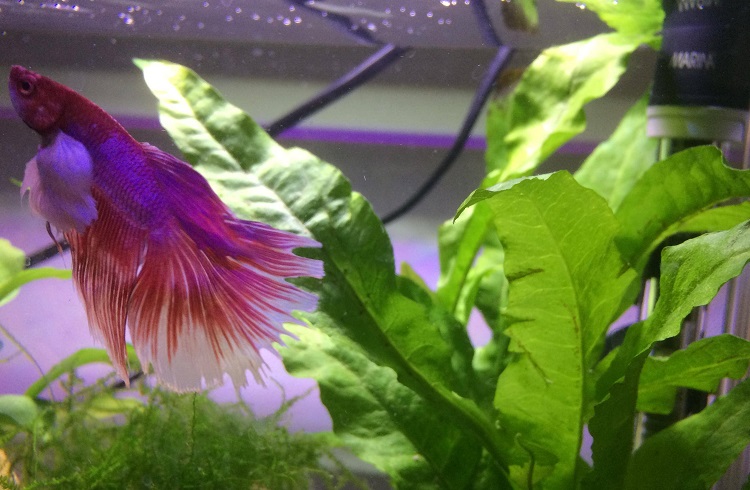
You need to reproduce the natural habitat of your Betta fish as much as possible if you want it to be healthy, happy, and live longer. Below, you can find all the information on how to set up the perfect tank conditions.
Perfect Tank For A Betta Fish
Betta fish need at least a fish tank that can hold up to two gallons. Ideally, pick a tank between five and 10 gallons. Of course, if you can do bigger, it’s always better in this case.
Before you buy or introduce your Betta fish to its tank, make sure that you wait a few weeks so the tank can cycle properly. Otherwise, good bacteria won’t have time to form, and the ammonia and nitrate levels could hurt your fish.
Cycling your new fish tank can also prevent health issues for your fish. This usually takes about a month.
Once it’s done, you can then insert substrate, a filter system, an air pump, a thermostat, a heater, and clean decorations and plants to keep your fish entertained. Bettas love to explore, so it’s good to add hiding spaces, such as plants, which can also improve the oxygen quality of the tank.
Then, you need to add water to the fish tank, control the temperature, pH, lighting, and filtration system before you add your Betta fish.
What Type Of Water To Use
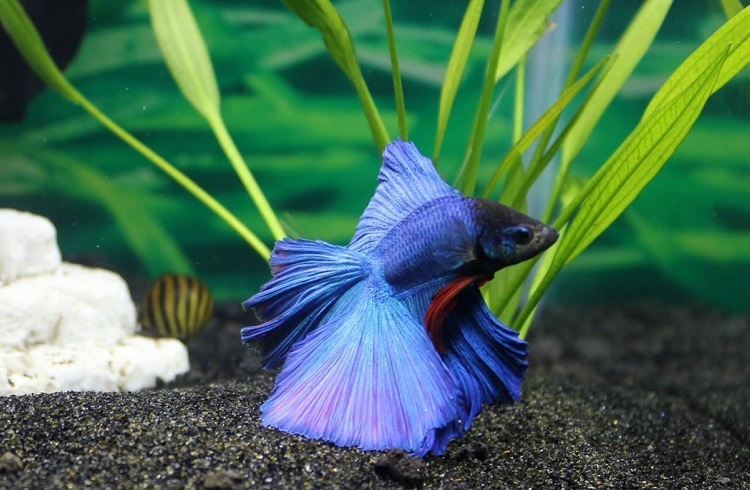
You should fill your tank with de-chlorinated water. Don’t use tap or distilled water. The pH of the water should ideally be between 6.5 and 7.
Temperature
The ideal temperature for Betta fish is between 72 to 86 degrees Fahrenheit.
Filtration
The best filters for Betta fish tank are sponge and internal filters. Whatever you do, it’s essential to pick a filter with a low flow rate. This reproduces the fish’s natural environment, which is in shallow and slow-flowing beds of water and rivers. They’re not used to fast or strong currents.
It’s up to you if you prefer to use a sponge or internal filters, as long as you get one of them, as filtration is essential to keep a high water quality and your Betta fish happy.
Lighting
This is the last step to set up your Betta tank before adding your fish in. Just like humans, Betta fish need light during the day and darkness during night time.
Artificial lighting can be controlled, while natural lighting can’t, and too much sunlight could grow algae in the tank. We advise you to install artificial lights, so you have full control.
If you choose to add live plants to your Betta tank, think about their lighting needs. Plants are good for increasing oxygen in the tank and providing shade and hiding spaces for your fish.
How to Take Care of Betta Fish in A Bowl
So you’ve decided to welcome a Betta fish into your life, but you don’t have a full-fledged aquarium at your disposal. Worry not; caring for your Betta fish in a bowl is possible. To successfully accomplish this, you’ll need to be meticulous in your care routine. Below is a comprehensive guide on how to take care of Betta fish in a bowl.

1. Pick the Right Bowl
The journey to a happy and healthy Betta fish starts with the bowl selection. Choose a bowl with a minimum capacity of 2.5 gallons. Bowls smaller than this can lead to deteriorating water quality, causing unnecessary stress for your Betta fish.
Opt for a glass bowl instead of a plastic one. Glass bowls are easier to clean and less likely to get scratched, enhancing your fish’s living conditions.
2. Water Changes
When it comes to bowls, many don’t come equipped with filters. Even if yours does, regular water changes are non-negotiable. Make it a practice to change the water in the bowl every two days. This ensures that waste accumulation (think fish feces) is kept in check, and essential nutrients are replenished.
Remember, the new water should be the same temperature as the existing water to prevent thermal stress on your Betta fish.
3. Water Quality
Contrary to what some may think, water quality in a bowl is of paramount importance. The optimal choice is dechlorinated or spring water. While tap water might seem convenient, it can be lethal to your Betta fish due to its chlorine content.
To dechlorinate, add two drops of a dechlorinating solution to the water and stir thoroughly before introducing your Betta fish back into the bowl.
4. Avoid Overcrowding
A word of caution—Betta fish are territorial creatures by nature. Placing them in a bowl with other Betta fish, especially those of the same species, is a recipe for conflict. If you value the well-being of your Betta fish, a solitary living arrangement is best.
5. Proper Bowl Maintenance
Lastly, maintaining your bowl’s cleanliness is crucial. Vacuum the substrate to remove any lingering debris and tackle any algae growth on the glass with a soft-bristle brush.
Never use harsh soap or chemicals when carrying out this task; such substances can be highly toxic to your Betta fish.
Feeding Your Betta Fish
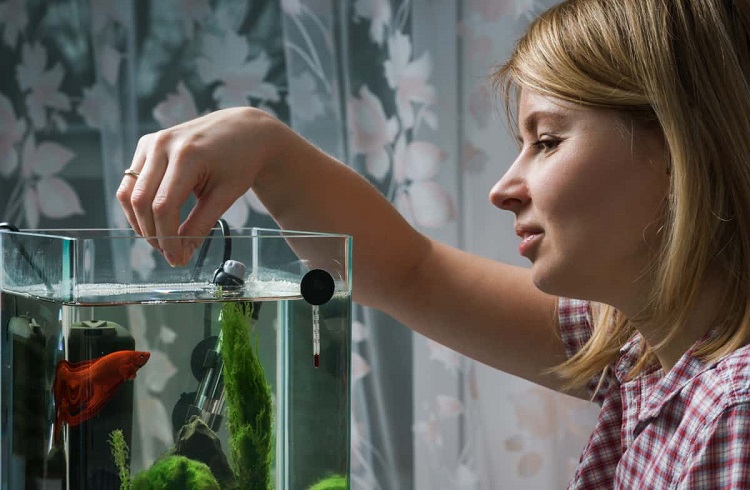
Betta fish are carnivorous fish. So you should feed your fish animal protein. In their natural environment, Bettas eat insects and even small invertebrates.
We recommend you feed your Betta fish pellets, frozen or dried food. Occasionally, you can give your fish live food like shrimp, krill, or bloodworms. While it’s nice as a treat and can be interesting to watch, some live foods could contain parasites. So it’s not recommended to give live food to your Betta fish too often.
You can buy pellets that are specifically designed for Betta fish, as they contain all the essential protein, nutrients, and vitamins your fish needs. Don’t overfeed your Betta fish. Once a day is enough. Otherwise, they will overheat, and this can deteriorate their health and the water conditions.
FAQ
Here is a quick FAQ where you can find all the answers you didn’t find in our guide above, as well as a recap.
Are Betta Fish Easy To Care For?
They’re a moderate care level. As long as you give them the right environment, feed them well and find the right tank mates for them, it should be fine from then on.
How Do You Take Care Of A Betta Fish As A Beginner?
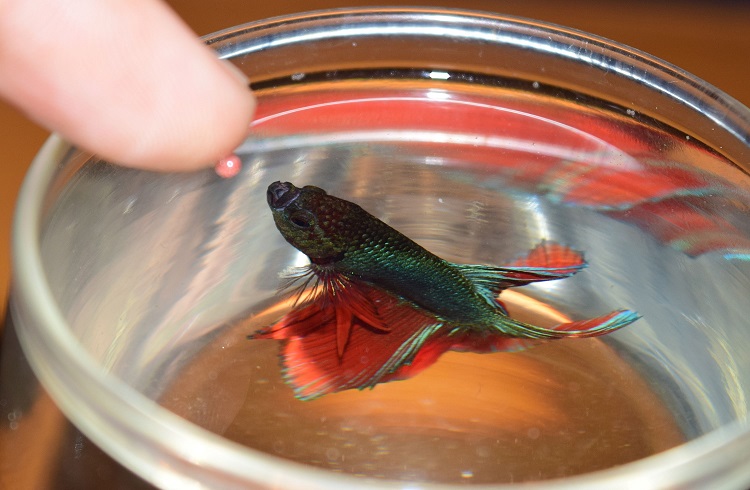
Simply read our care guide above. Reproduce the natural conditions of Betta fish as much as possible, and look out for any signs that could point that your fish is unhealthy.
How Do You Know If Your Betta Fish Is Happy?
If your Betta fish has all the exterior signs that it’s healthy, it should be happy. Add decorations and live plants so your fish can explore and keep entertained.
Can Betta Fish Live In Tap Water?
No, unless you use a Betta water condition to remove heavy metals.
What Are Some Fun Things To Do With A Betta Fish?
There are many games you can play, like introducing floating decorations, so your Betta fish can explore or play with them. Or you could place a ping pong ball in the aquarium, so your fish can push it.
There are so many options out there that will keep you and your Betta fish entertained!
What Is The Lifespan Of A Betta Fish?
The lifespan of Betta fish is usually three years. This can change depending on the care level you give them.
How Do You Know If Your Tank Is Too Small For Your Betta Fish?
The minimum tank size for your Betta fish is 2 gallons. Ideally, get a tank that can support five, 10, or more. Otherwise, it can be harmful and even fatal.
Which Is Better For A Betta Fish: A Tank, Or A Bowl?
A tank, and the bigger, the better. Even for other fish breeds, you should never use a bowl.
Final Thoughts
Betta fish can be tricky to care for, but they’re definitely worth it!

Ian Sterling, founder of Fishlab.com, began his aquarium journey over 30 years ago, driven by a deep fascination for fish and their diverse personalities. His website, Fishlab.com, is dedicated to making fishkeeping accessible and enjoyable, offering beginner-friendly guidance, expert insights, and a community for aquarists to connect and share experiences.


